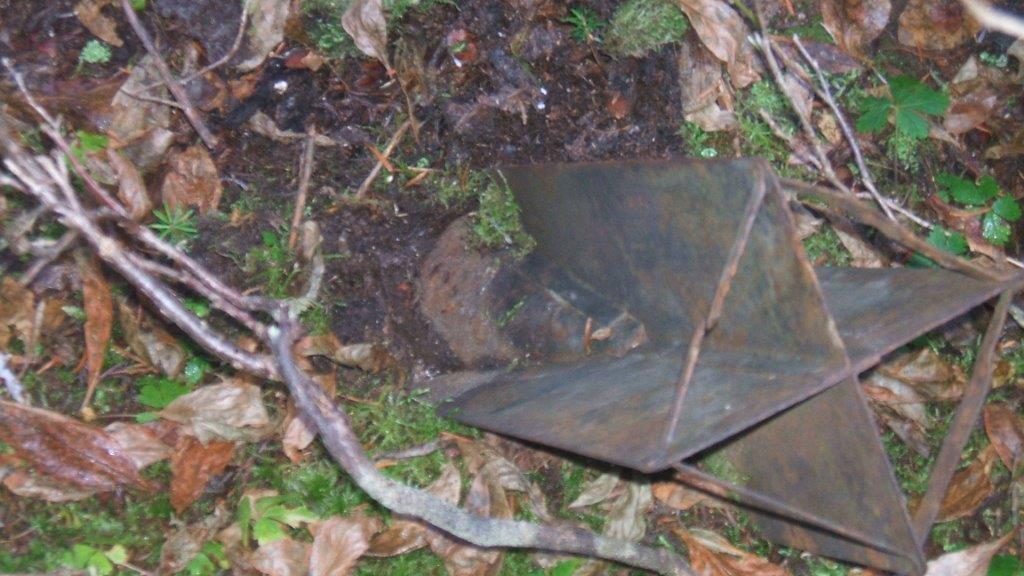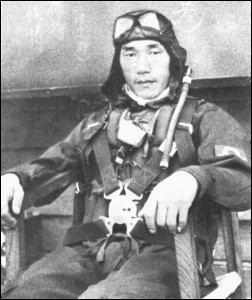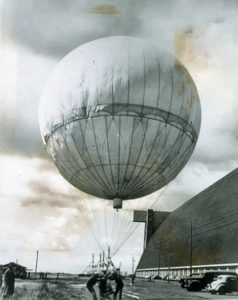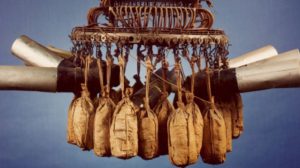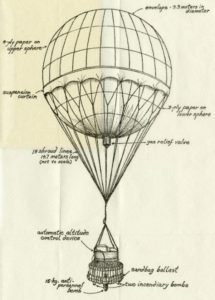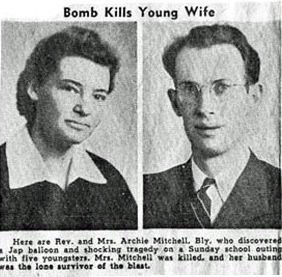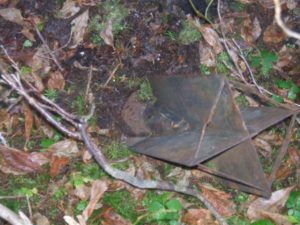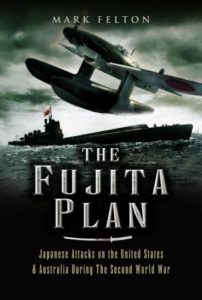Chief Warrant Officer Nobuo Fujita, the first man to bomb the United States from the air
How to bring the war to America was a question that the Japanese High Command gave considerable thought to between 1941 and 1945. Shore bombardment was tried, using surfaced Japanese submarines off the coast of California and British Columbia. Its effects were minimal. Tiny submarine launched spotter planes launched incendiary raids on the forest of the Pacific Northwest, again with little effect for a lot of effort. A massive effort was required to transport one very small aircraft across the Pacific on board a valuable submarine, to drop a tiny amount of bombs onto no specific target. At best it would have proved a propaganda coup had the United States authorities realized that Japan had successfully attacked the mainland, but no such media coverage was afforded.
Another munitions delivery system was required, and this time the Japanese decided upon an unmanned and ultra-cheap option: the paper balloon.
Once again, the Japanese required the initial utilization of their submarine force to attack the United States, and in 1943 two hundred balloons were prepared, to be launched from two modified submarines, the I-34 and I-35. Each balloon had a twenty-foot envelope, and a range of more than 600 miles. Although the operation was fully prepared by August 1943, the Imperial Japanese Navy realized that employing submarines on such missions would not have been a sensible use of their potential, especially as the war had long since begun to deteriorate for Japan. The project was shelved, and balloon bomb research and the Imperial Japanese Army continued development instead. The army lacked the means to launch balloons from a mid-point between Japan and the United States, so the new weapons had to be designed to depart from the Japanese homeland itself.
The army balloon-bomb project was codenamed ‘FUGO’ (Windship Weapon), and the army designers at the 9th Military Technical Research Institute under Major-General Sueyoshi Kusaba, in cooperation with scientists of the Central Meteorological Observatory in Tokyo, produced a balloon design, designated the Type-A (not to be confused with the navy’s Type-A midget submarine), made of sixty-four laminated mulberry tree paper gores (sections forming the curved surface of the balloon). This was glued together with a form of potato paste forming a balloon envelope with a 100-foot circumference. The envelope was then filled with 19,000 cubic feet of hydrogen to provide the necessary high ceiling the weapon required. Below the envelope was suspended a woven dural ring with bombs and thirty-six ballast sandbags attached, controlled by three aneroid barometers and a C (small) battery mounted on a platform above which controlled a circuit to maintain altitude, and release the bombs.
Each balloon carried a payload of two 11-pound thermalite incendiary bombs, and one 33-pound anti-personnel fragmentation bomb. The Japanese called the new weapon fusen bakudan or ‘fire bombs’. Launch sites were located on the east coast of the main Japanese island of Honshu, at Otsu, Ichinomiryu and Nakaso.
Once released, the balloons were uncontrollable, and carried to the North American continent at the behest of wind currents, cruising in the jet stream at around 20-40,000 feet. To maintain altitude, sand was automatically released from the ballast bags if the balloon began to sink. In the daytime the balloon would cruise at maximum altitude, but at night the envelope would collect dew, and sink as it became heavier. The altimeter would cause a set of blow plugs to fire, releasing sandbag ballast, restoring the balloon’s altitude. When all the sand was gone the bombs would become the final ballast, they being released automatically – an event calculated to occur over the mainland United States. Finally, a picric acid block would explode, destroying the balloon gondola; with a fuse being lit that was connected to a charge on the balloon itself. The resultant mixture of hydrogen, air and explosives would cause the balloon envelope to burn up as a large orange fireball. The balloons were extremely difficult to spot from the ground, because they cruised at such a high altitude, and most American fighter aircraft of the period could not reach them.
Diagram: Newcastle University
The first balloon launch occurred on 3 November 1944, with a US Navy patrol boat discovering a balloon floating in the sea sixty-six miles off San Pedro, California on 5 November. The first known successful attack on the United States occurred on 6 December 1944, bombs being dropped around twelve miles southwest of Owl Creek Mountain, close to Thermopolis, Wyoming.
Fragments of balloon envelopes and gondolas were discovered in Alaska and Montana, and forensic tests confirmed the wreckage to be of Japanese origin. The question was, how were the Japanese delivering the weapons to the United States? The people of the United States were not informed of the attacks, and the media was ordered not to report this alarming development. The United States also developed counter-measures to deal with this unique threat, codenamed ‘Operation Firefly.’ The US 4th Air Force gathered fighter squadrons to shoot down the balloons before they could release their payload, and many were downed over the Aleutian Islands before they could reach their targets as they sank to lower altitudes. One was shot down over Oregon. There was a fear among the American authorities that the Japanese could have used the balloons to deliver chemical and biological warfare agents to the United States, and to counter any such threat stocks of decontamination chemicals were quietly distributed to the western states, and farmers were asked to report any strange crop markings or animal infections that occurred. Although the United States authorities played down the potential damage that balloon bombs could wreak, Lyle Watts of the Agricultural Department commenting in June 1945 that, “…the forest service was “less worried about this Japanese balloon attack than we are with matches and smokes in the hands of good Americans hiking and camping in the woods,”” a US Army unit, 555th Parachute Infantry Battalion (nicknamed the ‘Triple Nickle’ because of their unit number) was trained to act as fire jumpers should the incendiary bombs set the forests ablaze.
Of the 9,300 balloons launched from Japan, only 212 were confirmed as having arrived in the United States and Mexico, landing as far east in the United States as Michigan, and a further seventy-three were confirmed coming down in Canada. The only fatalities caused by balloon bombs occurred on 5 May 1945, on Gearhart Mountain, near Bly, Oregon. A picnicking party of one adult and five children were killed instantly when they dragged an unexploded Imperial Japanese Navy 15-kg anti-personnel bomb out of the woods – these six people are the only known fatalities caused by enemy action on mainland United States during the Second World War.
It is not known whether any of the balloon bombs started forest fires, as was intended. In April 1945, the Japanese ceased their balloon launches, largely because of the American media blackout that had told them nothing about the success or failure of the campaign. What remains certain, however, is the fact that many of the bombs remain unaccounted for, and after over seventy years of deterioration could pose a serious risk to anyone who discovered one of these strange relics in the American countryside today.
A still live Japanese aerial bomb from a balloon discovered stuck in the ground near Lumby, Canada in October 2014. Photo: Infonews.ca
Proof of this claim was graphically demonstrated in Canada in 2014, when the remains of a balloon bomb’s gondola, including still live ordnance, was discovered near the town of Lumby. For more on this story, visit: http://infotel.ca/newsitem/unexploded-wwii-japanese-balloon-bomb-found-near-lumby/it13681
For more stories like these read The Fujita Plan: http://markfelton.co.uk/the-fujita-plan/
